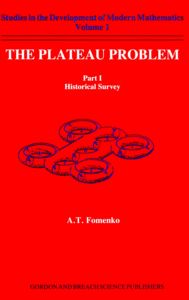Charting the historical origins of the Plateau Problem, the author discusses substantial extracts from 18th, 19th and early 20th century works devoted to the investigation of minimal surfaces, including Plateau's famous physical experiments. The theories of homology and cohomology, necessary for an understanding of modern multidimensional variational problems, are elucidated.
Explores the history and current state of the theory of minimal surfaces containing original research data.
Its clear presentation and numerous illustrations make this topic accessible to both students and research workers in the fields of mathematics and physics.
The Plateau Problem
Part I Historical Survey
Part II Present State of the Theory
List of Contents of Part I
Preface
I HISTORICAL SURVEY AND INTRODUCTION TO THE THEORY OF MINIMAL SURFACES
§1. The Origins of Multidimensional Variational Calculus.
§2. The Nineteenth Century, the Era of the Discovery of Basic Minimal Surface Properties.
1. Plateau's physical experiments and methods of forming soap films.
2. Physical principles underlying the formation of soap films.
3. The extremal properties of soap films and minimality of their area. The properties of the surface of separation between two media.
4. The surface of separation between two media in equilibrium is a surface of constant mean curvature.
S. Soap films of constant positive curvature and constant zero curvature.
§3. Topological and Physical Properties of Minimal Surfaces.
1. Stable and unstable surfaces.
2. Plateau's experiments with stable columns of liquids.
3. The physical realization of a helicoid.
4. The physical realization of a catenoid and its restructuring as the boundary contour changes. The change of the topological type of minimal surface in accordance with its stability or instability.
§4. The Plateau Principles. Minimal Surfaces in Animate Nature.
1. Two-dimensional minimal surfaces in three-dimensional space and the first Plateau principle.
2. The area functional, Dirichlet functional, harmonic mappings and conformal coordinates.
3. Singular points of minimal surfaces and three Plateau principles.
4. The realization of minimal surfaces in animate nature.
II SURVEY OF SOME IMPORTANT PUBLICATIONS IN MINIMAL SURFACE THEORY FROM THE NINETEENTH TO THE EARLY TWENTIETH CENTURY
§1. Monge (1746-1818).
§2. Poisson (1781-1840).
§3. Plateau (1801-1883).
§4. Some works of the Early Twentieth Century Rad6, Douglas).
§s. Minimal Surfaces in the Large.
III SOME FACTS FROM ELEMENTARY TOPOLOGY
§1. Singular and Cellular Homology Groups.
1. Singular chains and homology groups.
2. Cellular complexes, barycentric subdivisions.
3. Cellular homology and computation of the singular homology of the sphere.
4. Theorem on the coincidence of the singular and cellular homology of a finite complex.
5. The geometric determination of cellular homology groups.
6. The simplest examples of cellular homology group computations.
§2. Cohomology Groups and Obstructions to the Extensions of Mappings.
1. Singular cochains and the coboundary operator.
2. The problem of the extension of a continuous mapping from a subspace to the whole space.
3. Obstructions to the extension of mappings.
4. The cases of the existence of the retraction of a space onto a subspace which is homeomorphic to the sphere.
References and Bibliography
Index
with TOC BookMarkLinks
Brief Contents of Part II: IV MODERN STATE OF MINIMAL SURFACE THEORY
§1. Minimal Surfaces and Homology.
§2. Integral Currents.
§3. Minimal Currents in Riemannian Manifolds.
§4. Minimization of Volumes of Manifolds with Fixed Boundary and of Closed Manifolds. Existence of a Minimum in Each Spectral Bordism Class.
§5. Generalized Homology and Cohomology Theories and Their Relation to the Multidimensional Plateau Problem.
§6. Existence of a Minimum in Each Homotopy Class of Multivarifolds.
§7. Cases where a Solution of the Dirichlet Problem for the Equation of Minimal Surfaces of High Codimensions does not Exist.
§8. Example of a Smooth, Closed, Unknotted Curve in R3 , Bounding Only Minimal surfaces of Large Genus.
§9. Certain New Methods of Effective Construction of Globally Minimal Surfaces in Riemannian Manifolds.
§10. Totally Geodesic Surfaces Realizing Non-Trivial Cycles, Cocycles, and Elements of Homotopy Groups in Symmetric Spaces.
§11. Bott Periodicity and Its Relation with the Multidimensional Dirichlet Functional.
About the Author
Professor A.T. Fomenko was educated at Moscow State University. He graduated with a DSc in 1972. and won the Award of the Moscow Mathematical Society for his doctoral thesis in 1974. In 1987 he was presented with the Award of the Praesidium of the Academy of Sciences of the USSR.
Professor Fomenko has obtained fundamental results in the fields of geometry, topology and multidimensional variational calculus. as well as being involved in scientific methodological work and teaching.
In Collection
#7615
Read It:
Yes
#7615
Read It:
Yes
Mathematics
|
|
||||||||||||||
